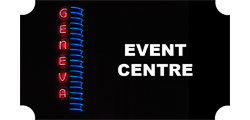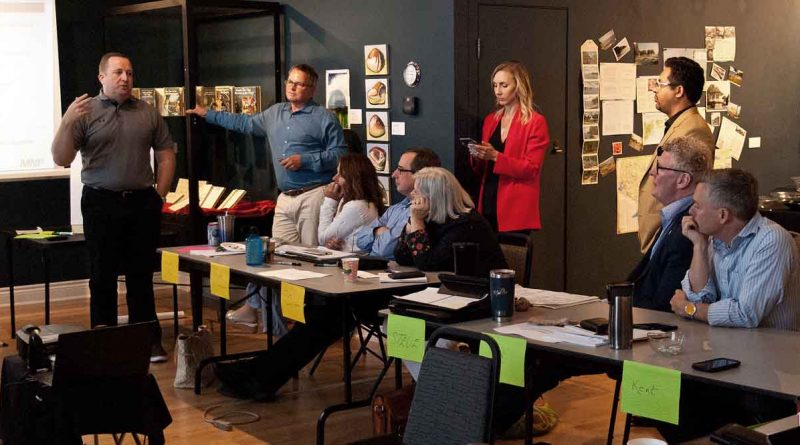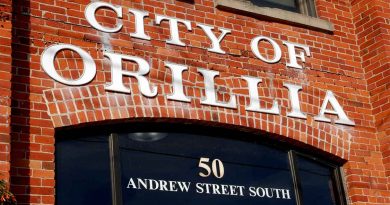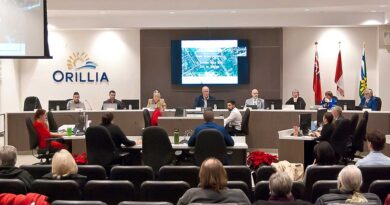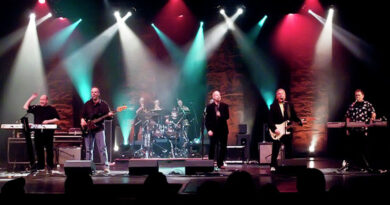Orillia’s Strategic Plan
By John Swartz
Orillia council and staff spent all day Thursday in second public meeting to hash out a strategic plan to guide their activity for the next three years of their term, and hopefully beyond.
“It was an action packed two days. It was well facilitated,” said mayor Steve Clarke. He compared the process to the Downtown Tomorrow plan, believing the final product will be useful for many years.
“They (2010 – 2014 council) did such a good job with that, that’s a document that is still very valid and relevant today,” said Clarke. “I’m hoping that this document we put together with staff’s input, council’s input and the public’s input is the same thing,”
The previous day, consultants from Meyers Norris Penny LLP (MNP), Jason Burgess and Jason Ducharme, worked with the group to arrive at a preliminary wording for a vision statement they presented for discussion Thursday.
“We’ve got wording, two versions of a vision statement. There is just some tweaking of the vision statement. What we’re going to do is come up with the final version that will be included in our documentation,” said Ducharme. There were 4 versions, but council and staff gravitated toward the third of the group as almost what they wanted, so long as some part of another version could be worked in. It will look similar to this in its final form:
”Orillia is a progressive, small city offering an exceptional quality of life with two beautiful lake fronts, a vibrant and diverse economy, a passionate sense of community pride combined with progressive and respectful citizens and sustainable growth.”
They also spent some time coming up with 6 categories to organize the various ideas voiced.
“The idea is we are going to have defined vision, we’ve got the six themes that contribute to the vision. For each of those themes we identified a number of specific goals. This is the guts of where we came to,” said Ducharme.
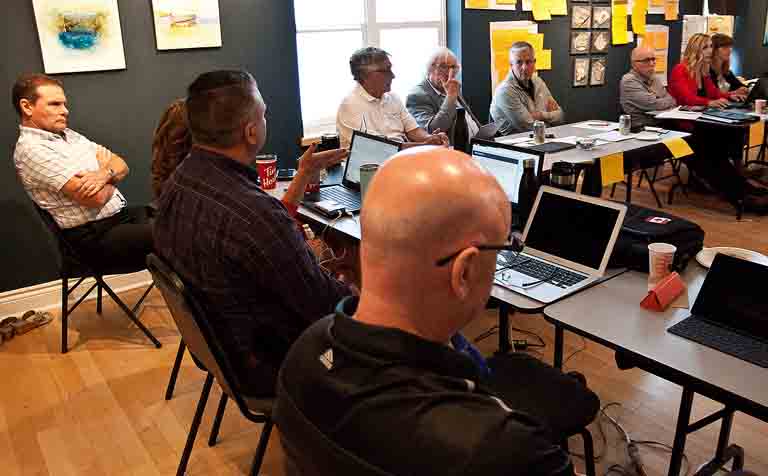
Themes And Goals
Excellent Quality of Life – 1, explore opportunities to increase recreation; 2, improve health and wellbeing; 3, pursue a welcoming and caring, inclusive and accessible community; 4, support and enhance culture, arts and an active lifestyle; 5, provide supports and services for vulnerable citizens with a strong partnership with the County.
Vibrant Waterfronts – increase and promote accessible, vibrant, exciting, year-round waterfronts
Heritage Core – create a revitalized, vibrant, unique, heritage-oriented, pedestrian-friendly core area connected to the waterfront.
Sustainable Growth – 1, manage growth to effectively balance residential and employment; 2, create adequate serviced land to accommodate 40,000 residents and employment opportunities; 3, develop the City to be a year-round destination for tourism, cultural activities, sports, active living, accommodation and trails; 4, manage growth with focused infrastructure investments which encourage an environmentally attractive, affordable, diverse, financially sustainable, and technologically enabled communities.
Healthy Environment – continue the City’s commitment to environment stewardship by increasing waste diversion, reducing carbon footprint, protecting urban greenery, and ensuring clean, safe water.
Well Run City – 1, leverage technology to better operate the City, connect with citizens and businesses and optimize business intelligence; 2, deliver leading edge, efficient and effective services that are client-centric and business friendly; 3, build organizational capabilities to support leadership, succession, recruitment, customer service and competencies; 4, mange the City’s finances to ensure long-term sustainability, fiscal responsibility and efficient delivery of services.
Mission Statement
Of course, all that needs to be wrapped up in a mission statement, as these things tend to go, which distills those things down to what amounts to an elevator pitch:
”Orillia is a progressive, small city offering an exceptional quality of life with two beautiful lake fronts, a vibrant and diverse economy, passionate sense of community pride combined with progressive and respectful citizens and sustainable growth.”
A good part of Thursday afternoon’s session involved weeding through 42 specific actions that fit into the goals of the categories. They were arranged on the wall using sticky notes, aligned along a grid with the degree of effectiveness (short and long term) along the Y axis and cost along the X axis.
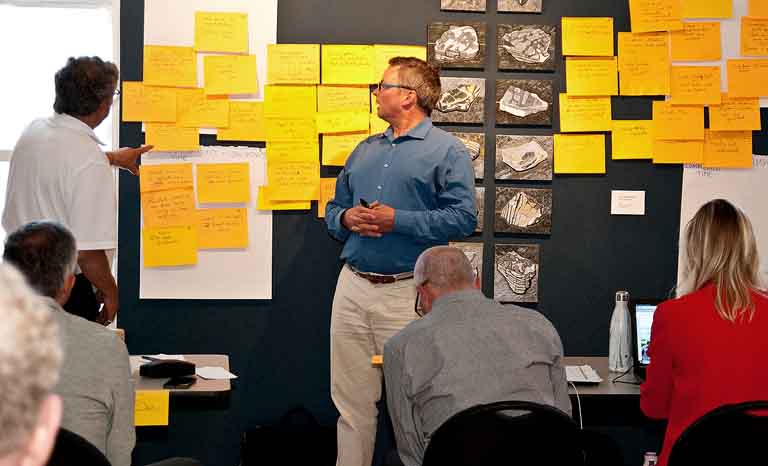
Some of the 42 specific actions which may make the final cut included banning single-use plastics, encouraging creation of off-season festivals, using larger commercial green and blue bins, creating grey water recovery rebates, a phase 2 development of the recreation center (arena), LED streetlights and Smart traffic lights, facilitate the relocation of the legion, using technology to create a ‘one door’ service point for residents, managing storm drainage better, create refillable water stations, formalizing a relationship with Sustainable Orillia, coordinating the various arts groups, and free parking for residents.
The idea was to tweak positions from how the consultants arranged them. This proved to be a Sisyphean task as councillor after councillor questioned and debated where their pet project should be on the grid.
Counicllor Ted Emond pointed out some of the simple policy change ideas, which could be immediately effective and cheap, could in the long run turn out to be expensive and he suggested that maybe some more thought and input from staff should be acquired before final placement on the grid. As more of the 20 people from City Hall participating chimed in on the merits of at least enacting some policy change and looking at how it may play out later, Ducharme came to the conclusion it might be best for the consulting team to wade through the items and get some feedback from staff on long-term consequences of some of the seemingly minor changes. Steve Clarke observed that while that part of the session was starting to bog down, the consultants wisely offered an out and moved on to the final stage of the session.
“There’s always a desire for people to start getting into the minutia of some of the actions and debates in this kind of process, but this really was an overview, a setting of the stage, and beginning to mine down into some of those actions. People get so excited they want to start talking about some of the actions right away, but beyond that it was a great process,” said Clarke.
The last stage of the day was discussing the next steps, which includes meeting with the public.
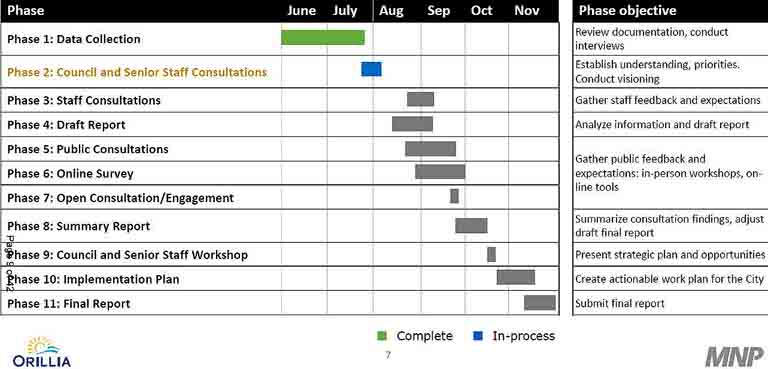
“We’re going to have public consultations in early fall. It hasn’t been finalized yet, but there will be multiple options for them to participate. We’re evaluating online surveys, we evaluating virtual town halls and actual town halls, what we call pop up polling where we go out into the public and do some polling, and also stakeholder groups,” said Burgess.
In the mean time the consultants hope to have the input gathered, along with the statements, goals and actions dressed up in an easier to understand document for those groups to consider. The goal is to have a final report for council in November.
“It should be something that is very relevant and very useful for a number of years to come. And our hope all along, whenever we make a decision at council at the bottom of every report it should say how does this fit into our strategic planning; it needs to identify the win because if it’s not doing that you’re probably going a little too madly off in different directions,” said Clarke.
Of course, everyone participating had in mind the City is already involved in a number of multi-year projects and an often heard sentiment was those things are stage setters for the things which come out of this strategic planning exercise.
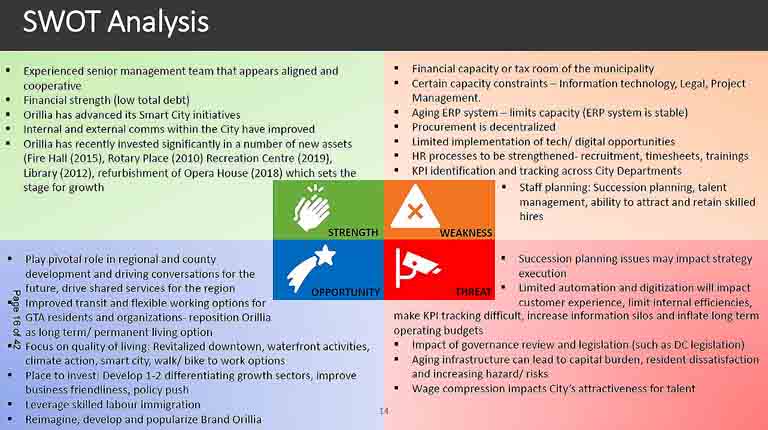
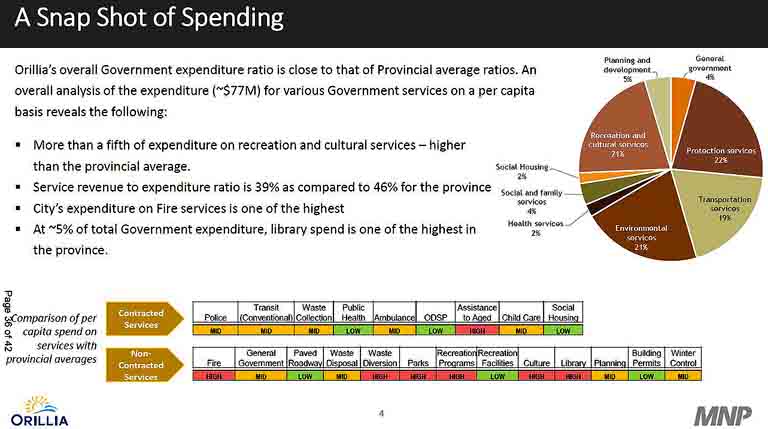
(Photos by Swartz – SUNonline/Orillia, Images Supplied) Main – Jason Burgess (speaking), and Jason Ducharme (standing) lead Orillia council and staff at this week’s strategic planning session.
![]()

